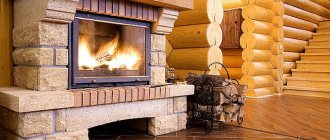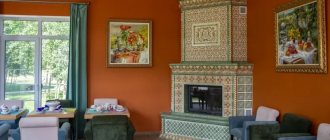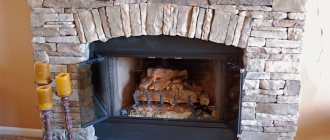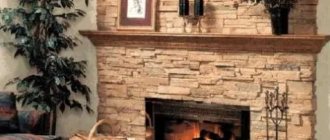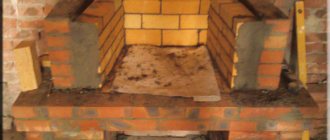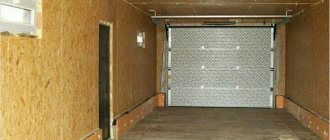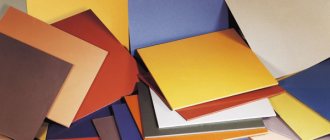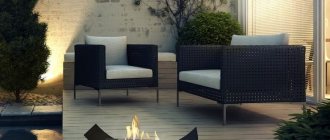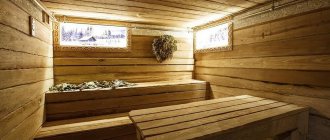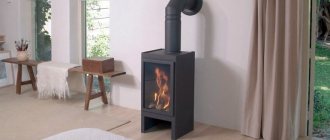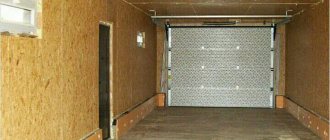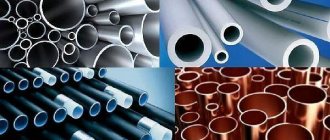The stove has been used for heating homes since ancient times. The demand for such a center is still observed today. When constructing houses and cottages, many developers often include the structure in the project. At the same time, they understand that the appearance of a traditional heat source is no less important than its functionality. Heat-resistant tiles for stoves and fireplaces are used as a finishing material.
If you can even use plasterboard, plastic panels imitating stone or brick to cover a false fireplace, then only special plates, mainly made of baked clay, are suitable for decorating heating devices. Manufacturers produce a wide range of products. The choice of a specific option depends on various factors - cost, manufacturer, compliance with the interior, personal preferences.
Features of choosing tiles
The decoration of the fireplace performs not only a decorative function. It extends its service life, protects the seams of the brickwork from destruction, and protects the structure from mechanical damage. It also allows you to increase the heat capacity and heat output of the furnace. When choosing tiles for cladding, you should adhere to certain rules and recommendations for the following parameters:
- Environmental friendliness. The tile itself is an environmentally friendly material and does not emit toxins when heated (although this is possible). The adhesive used during installation poses a great danger.
- Heat resistance. The product must withstand heating up to 1000°C or more, and the coefficient of thermal expansion must be less than 7-8%. On the packaging, heat resistance is indicated by the letter “T”. It is also worth paying attention to the icon depicting a flame with numbers inside. It indicates the number of firings.
- Moisture resistant. This parameter should not exceed 3%. “E” is used to indicate water absorption; the number following it indicates the coefficient.
- Thermal conductivity. This indicator affects the heating of the room, maintaining a high temperature in it for a longer time.
- Wear resistance (PEI). This parameter is inherent exclusively to floor-standing options.
- Inert to chemical influences. Icon in the form of a flask on a black square background. Products of class AA are completely neutral to household chemicals, D - the most unstable, completely lose their original appearance.
- Variety The number of products with defects in the batch depends on it. The colors used for marking are: red, blue, green, black. The first corresponds to the 1st grade (<5%), the second – to the 2nd (5-25%), the third and fourth – to the 3rd (> 25%).
- Thickness. Preference should be given to materials whose thickness exceeds 8 mm.
Some product quality parameters can be assessed visually, for example, design, glaze condition. To determine the curvature, it is enough to take two copies from different packages and place them face to face.
Glue for work
Good craftsmen advise working with the glue solution without using special equipment, just with your own hands. The solution is prepared for fifteen minutes before use, which is applied using a metal spatula. Furnace finishing with ceramic tiles is done from top to bottom. Subsequently, the tile is attached to the surface, lightly pressed with the second hand or knocked down with a rubber hammer.
The rules for laying tiles are similar to the general laying stops in any corner of the house
A special luxury...
To obtain even seams, it is recommended to use certain crosses. In order to find out whether each tile is positioned correctly, you need to use a level to check.
And real brutality... In this example, the ceiling beam rests on the stove pipe, which probably led to the alteration of the chimney
The fire element is concentrated in one place: fireplace, candles...
When the glue solution begins to stick, it will be necessary to remove its remnants from the surface using a soap solution. After 24 hours of finishing the stove with ceramic tiles, the seams are filled with a special mixture using a spatula. The remaining debris must be eliminated using special compounds and the surface wiped with a damp cloth. However, after finishing the stove with ceramic tiles, you should not use the stove immediately. It is recommended to wait two or three weeks.
The main problem when finishing stoves with ceramic tiles is considered to be uneven heating of various areas and walls of the stove in depth. It follows that the tile can fall off at any moment. You need to know that to finish a stove with ceramic tiles, it is necessary to use a clay-based solution as a connecting link. The stability of clay under the influence of elevated temperatures only increases over the years.
Types of tiles used for finishing stoves and fireplaces
There are many types of heat-resistant tiles. The facing material differs in composition and external characteristics. The choice of the appropriate option will depend on many factors: the purpose of the furnace, operating conditions, etc. The surface of a home fireplace is subject to severe thermal stress. To avoid cracking of blocks and lag behind the masonry, it is necessary to competently approach the task of choosing tiles and the installation method. Failure to comply with the technological process will lead to a rapid loss of the original appearance. Each type of laying element has its own characteristics.
Terracotta
The elements have a smooth, polished surface. The tiles are made from white clay by firing at temperatures up to 1000°C. The production technology does not provide for the addition of coloring pigments or chemical elements. In addition to excellent heat resistance, it has an interesting appearance and unusual structure. The pattern can consist of several natural shades; there are combinations of savage stone, wood, and brick. The color range is from beige to dark gray.
The shape of the finished product is hexagon, square. The thickness of the fireplace tile is up to 8 mm. Terracotta differs from other facing materials for stoves by clear advantages. The universal tile color makes the cleaning process easier; small grains of dust will be invisible. Serious stains can be removed with a damp cloth. The original appearance will complement any interior. The material increases heat transfer several times; a stove finished with it will heat the room much faster.
Terracotta can be used to decorate outdoor stoves. The tiles do not fade in the sun and tolerate frost. You can install it yourself without special skills or complex tools. Use the standard and seamless installation method. Some types of terracotta have special locking systems.
Majolica
Ceramic heat-resistant tiles are covered with glaze. The main feature of the material is the presence of painting on the surface. Depending on the type of pattern, there are many varieties. Gzhel, Moroccan, and Egyptian patterns are especially popular. Stove tiles are not suitable for all interiors. By the drawing you can distinguish expensive options from cheap fakes.
Majolica has all the characteristics of terracotta, but has a denser structure due to the complete filling of the pores with glaze. This feature precludes its use in a humid environment (bathhouse, kitchen). These tiles are not mass produced. More often they make a limited batch for a specific oven. The design is applied manually or using special forms. On high-quality models that imitate natural materials, repetitions of patterns and images are very rarely found. The labor-intensive process of making majolica significantly increases its cost.
Tile
One of the most popular finishing options, although the material does not have sufficient characteristics. Any type of heat-resistant tile is very susceptible to temperature changes. If you decide to use ceramic parts for lining the stove, you need to choose elements without glazing. Their size should not exceed 20x20 cm. The material cannot be used outdoors.
Place ceramine on a special fire-resistant mastic or glue. They also use the technology of mounting in metal frames. Cement and clay solutions are not suitable because the material does not absorb moisture at all. Decorating a fireplace or stove with tiles can be done in one tone or varied in patterns.
Clinker tiles
When choosing a facing material for a stove, many experts are inclined towards this option as the most profitable and successful. Clinker is made from high-grade refractory types of clay. Increases temperature resistance through repeated firing.
Clinker tiles have a modern design and a huge number of color options. Elements can be glazed or unglazed. The material has the following characteristics:
- Naturalness. Clinker is produced without chemical additives and artificial dyes;
- High resistance to mechanical stress;
- Resistant to temperature changes. The material is used for interior and exterior work;
- Low level of moisture absorption;
- Wide range of types and sizes. Can participate in a project of any style.
Tiles
Elements are formed from clay by pressing, then fired at high temperature. The reverse side of the tile has special edges that make the box shape special. Thanks to this, its heat-saving properties increase.
Installation of tiles requires the use of additional elements due to the complex shape of the parts. Mechanical installation requires preliminary installation of special brackets and rods. The surfaces of the fireplace, on which there are tiles, do not heat up to high temperatures. They can be touched with your bare hand without the risk of getting burned.
The main value of the tile is its high aesthetic properties. Thanks to the variety of sizes and patterns, a fireplace with this finish will look great in any style. The shape of the parts can be flat, angular, shaped. When laying tiles, it is not allowed to divide or cut it, otherwise it will lose its unique accumulative properties.
Fireclay tiles
The material has a complex composition. It is made from a mixture of several types of refractory clays and stone flour. The thickness of the elements is 10-30 mm. Some types of slabs are equipped with special locks, which allows you to create an almost monolithic finish.
Fireclay tiles have high moisture resistance and heat resistance. It can heat up to 2000°C without deforming, without compromising its appearance. The low coefficient of thermal conductivity of the material allows the furnace to maintain temperature for a long time, gradually releasing it to the room.
Products for lining furnaces with the addition of fireclay are characterized by increased strength and resistance to alkalis, acids, and solvents. Fireclay tiles are produced in limited quantities. The high cost is justified by decent quality characteristics and an individual approach to each order.
Porcelain tiles
The material allows you to make a high-quality finish of the stove in a modern style. Porcelain stoneware is used for finishing the facades of any heating units. Such tiles are obtained by dry pressing by mixing clay, homogeneous mixtures of kaolin, quartz sand, and pigments. Its popularity is easily explained by its special physical and chemical properties. This is a low coefficient of abrasion, high mechanical strength, resistance to moisture and temperature changes.
Fire-resistant porcelain tiles are available in different colors and textures. You can purchase facing material with any finishing surface structure. The following types of textures are popular:
- Glazed. The front side of the tile is treated with an enamel compound, which hardens and acquires special strength after firing;
- Waxed. The surface shine is achieved by crystallizing the top layer before the material is fired;
- Matte. It is not processed additionally after firing, which reduces the cost;
- Rectified. The required size and shape are achieved by cutting the side parts using special equipment;
- Polished. After exposure to temperature, the surface is cut and polished - shine and a clear pattern appear. The tile requires careful care due to the porous structure of the top layer;
- Semi-polished. The surface is partially cut off, which makes the top layer combined - alternating dullness and shine.
Marble
In addition to tiles, marble columns, figurines, corners, arches and other overhead elements are used to decorate fireplaces, emphasizing the aristocratic design. The variety of plates themselves in color and size makes it possible to choose the appropriate option for the overall style of the room.
Before installing the tiles, it is necessary to strengthen all surfaces of the heating unit. To do this, a reinforcing mesh is placed on a layer of plaster. Marble tiles are not produced more than 10 mm in thickness, but even such a cross-section with a large number of elements may be enough for the cladding to collapse at the slightest vibration.
The job of tiling a fireplace with marble tiles is not easy. The difficulty lies in the careful selection of elements and the choice of adhesive mixture. Parts from the same package may have different pattern directions. It is necessary to compare the veins harmoniously and transfer the overall picture to the fireplace. The glue should not leave any traces on the noble surface. The seams are filled with special mastic.
Fake diamond
Finishing materials similar to natural tiles are not inferior to them in terms of performance characteristics. Artificial stone is made from gypsum or Portland cement with the addition of expanded clay. All substances are mixed and poured into molds made in the likeness of natural stones. The advantages of cladding with this type of material are as follows:
- Aesthetic appearance;
- Heat resistance;
- Light weight of elements;
- Successful imitation of natural stone;
- Ease of processing. You can create elements of any shape and size with your own hands;
- Long service life;
- Possibility of combination with tiles from other materials (ceramics, natural stone, marble).
What is and purpose
Refractory tiles are, according to the definitions given in GOST 28874-2004 and GOST R 52918-2008, a type of molded refractory materials (products), since they are characterized by certain geometric shapes and standard sizes available for all serial products.
The main purpose of tiles made from both natural finishing stones and artificial ceramic materials, regardless of its type, be it ceiling, facade or floor, is decorative, protective cladding of the surfaces of building structures, heating household, industrial equipment, including stoves , fireplace, without which a modern bathhouse, sauna, residential or country house is impossible.
Fireproof materials and their fire resistance
Ceramic heat-resistant tiles are multifunctional products that allow solving several problems facing customers - from builders constructing objects for various purposes to private property owners:
- Create a unique interior in a residential, country house, bathhouse, sauna, using fire-resistant tiles that are suitable/liked in appearance, texture, color, pattern for decorative cladding of the external surfaces of stoves, fireplaces, including fire-resistant cuts and offsets; as well as stationary grills and barbecues located in personal plots.
- To provide protection against overheating of heating equipment, to reduce the possibility of thermal damage to people using it at home and at work.
- Increase the heat capacity of stoves and fireplaces, increase the uniform heat transfer of heating units by creating even, smooth outer surfaces that effectively act as heat shields.
Tile sizes
For cladding fireplaces and stoves, you need to choose small tiles. Since the heating unit itself in the house does not have large dimensions, the material must be selected harmoniously. It is easier to make a beautiful design or pattern from small parts, but large ones will have to be trimmed often. Finishing with brick or natural stone tiles looks better if you use elements in their natural size.
Popular sizes of tiles for stoves are 10x10 mm, 15x15 mm, 18x18 mm, 6x12 mm, 6x18mm, thickness - within 8 mm. Installation of materials begins from the corner and moves towards the wall. The places where the material meets the surface are decorated with cut parts.
The format of the fireplace decoration should be commensurate with the proportions of the room itself. All elements must be even and proportional. The slightest deviation of one of the sides can lead the entire row to the side.
Materials
Today there is a huge variety of different finishing materials on the market: from ordinary plaster to real stones. This depends on your own preferences, taste and finances. Experts in this industry advise using heat-resistant ceramic tiles, which look more attractive and can fit seamlessly into different interiors.
This stove is a historical heritage
And such a stove can confidently claim its heritage. Design using real tiles, which are now produced in limited quantities for individual customers
Ceramic tiles for stoves have such necessary qualities as:
- fortress;
- fire resistance;
- heat conductivity;
- hardness;
- environmentally friendly, making it the best option.
Color spectrum
The color of tiles for stoves and fireplaces should be matched to the overall design of the room. Clinker plates are presented mainly in natural shades - from pure white to chocolate. The range of shades of porcelain stoneware is simply huge. With its help you can create a designer unique finish for a heating unit.
If it is necessary to emphasize the naturalness of the hearth, to bring the structure as close as possible to a rustic stove, choose terracotta of a natural clay shade for cladding. Marble plates, majolica, and tiled elements are produced mainly in light colors, complemented by painting and various patterns.
Working conditions
It is necessary to carry out such work only in the summer, when there is no need to operate the stove. How to cover a stove with tiles, the video in this article will help you understand the general process that the stove maker performs. Whatever method people choose for lining a brick kiln, they must take the work very seriously.
In any case, the main thing is the final appearance, reliability of operation and of course the heat of the stove
If you have doubts about your personal abilities, it would be best to entrust the work to specialists who know how to properly tile a stove. They certainly know how to glue tiles to the stove.
You don’t have enough money for tiles, be smart, plaster the surface and stick on decors
Covering any object with tiles is not a problem for them, and covering any masonry allows them to realize their potential. In addition, they will see if the stove can be tiled.
The option with a natural stone finish is considered a good solution
Although ceramic tiles are most often used for cladding, which usually last ten or fifteen years, but then the result is not guaranteed. Cladding of various stoves using any type of tile is quite the main stage, which makes it possible to extend the life of a family home and create comfortable conditions for further living together.
Stylistic directions
An indoor fireplace is a multifunctional unit. In addition to heating, it performs important aesthetic functions and is an original decoration of the central room. The finishing method and the shape of the tiles have a significant impact on the overall style of the room. You can make your fireplace attractive in a variety of ways. Using facing tiles you can decorate a stove or fireplace in the following styles:
- Under Gzhel. They use majolica and tiles of various shapes. A unique design is created individually for fireplaces in rustic, ethno, country styles;
- Imitation of brickwork. Decorating a fireplace in a modern style using brick-like tiles allows you to create a unique atmosphere. Minimalist design involves completely hiding the heat source behind a brick false wall;
- Under a stone. Modern production technologies make it possible to decorate the fireplace with tiles that imitate the texture of natural stone. This material looks great in the English style, chalet, Provence;
- Mirror tiles. The finish is suitable for modern interiors in Scandinavian style, minimalism, hi-tech. Elements with reflective glossy surfaces are often placed inside the hearth to create the effect of flame reflection;
- Panel. You can lay out an original panel over the hearth using porcelain stoneware, clinker tiles, or tiles. Patterns with natural motifs and original drawings will fit perfectly into the oriental, eco style.
Design
The determining factor when choosing a stove cladding design is not the type of material, but the interior of the room in which it is located. A characteristic feature of the design of facing tiles specifically for stoves is the almost complete absence of geometric patterns.
It is not found in almost any style.
But the design of such products is replete with complex ornaments:
Floral patterns, characteristic of majolica or tiles, can be used in almost all styles - from classic to modern. Faience with its famous blue and white Gzhel color scheme would also be appropriate.
For a classic interior, you can choose porcelain stoneware; its possibilities are almost limitless. With it you can create entire paintings.
A modern interior does not imply too colorful decoration. Elegant monochromatic tiles with small splashes of decor would be more appropriate here. Various imitations of malachite and marble, as well as wood, will look good.
In a hunting lodge or country cottage, you can use natural stone. In order not to reduce the cost of the interior, you should not mix natural material with other types of finishing; it works well alone.
Real stoves are rarely found in techno or futurism style interiors. However, if elements of such design trends are still present, a plain tile would look good here.
In a country house, terracotta and clinker would be appropriate. Images of plants and flowers in the Khokhloma style will be especially good.
Laying rules
The stove is the focal point in the interior. It should always look beautiful and symmetrical. Cladding work is proceeding according to the preliminary plan. First of all, you need to decide on the type of installation and material, and calculate the required number of tiles. You can handle laying some types of plates yourself. For complex work with preliminary preparation of the base, the help of an experienced craftsman will be required. Installation of tile materials is carried out according to certain rules.
Which solution to choose for installation
Tile mortar can be purchased in powder or jelly form. The range of adhesive mixtures for lining furnaces is very diverse, which allows you to choose the appropriate option for a specific type of plate. They differ in composition and purpose as follows:
- Sand-cement mortar. Used for laying ceramic and gypsum tiles. The composition includes Portland cement, water, sand;
- Clay solution. Suitable for tiles, tiles, majolica. Composition: clay, water, fillers. Under the influence of high temperature, the material gains strength;
- A mixture of clay, sand, cement. It has a complex composition that complements liquid glass and ground chalk. Heavy tiles (marble, fireclay, porcelain stoneware) are placed on it;
- Mastic. Heat-resistant compounds are made from clay, cement, latex, bitumen with the addition of turpentine, and solvent. The proportions depend on the type of material and the method of its installation.
How to prepare the base
Stove tiles can only be laid on a flat surface. If it is an old fireplace, all layers must be removed, leaving a bare brick surface. The remaining mortar must be knocked out of the intermediate seams, going at least 1 cm deep. The work can be carried out manually using a metal brush or using a grinder and a special nozzle.
Now the base of the furnace must be cleaned of dust and treated with primer. The mixture is applied in several layers until it stops being absorbed. The reinforcing mesh is fixed to the surface using dowels and primed again. The mesh is coated with plaster mortar. After it has completely dried, you can apply a leveling compound and install beacons.
Seam processing
Grouting of tile joints begins a few days after installation. Use special heat-resistant mixtures of a suitable tone. The work is carried out using a rubber spatula or a special gun. Depending on the final result and the style of the fireplace, choose a grout with the desired structure, which will make the seams rough or completely smooth.
Mixtures for treating joints have different compositions. Their main task is to generally strengthen the finishing array, protect against harmful influences, and give an aesthetic appearance to the fireplace or stove. They produce cement and epoxy grouts. Some mixtures are applied in a non-standard way, spreading over the entire surface of the tile. After complete drying, the excess part is removed from the surface using a sponge.
Properties and characteristics
Any types (types) of fire-resistant tile products, regardless of materials, methods of their manufacture, must have the properties required by construction, fire safety, and sanitary standards:
- Fire resistance – the ability to withstand short-term temperature exposure up to 1000 ℃.
- The maximum heating temperature on the outer surface during operation under normal conditions, which, depending on the category and purpose of the furnace equipment, varies in the range from 100 ℃ (moderate heating) to 120 ℃ (high temperature heating). The temperature limits for each type of refractory tile are determined during testing and are indicated in the accompanying technical documentation for each batch of products.
Determination of fire resistance limit
- The absence of toxic substances in the composition, including those formed during high-temperature heating, which is solved by the use of fire-resistant natural raw materials or natural materials without harmful impurities.
- Thermal conductivity, heat capacity, important properties that make it possible not to reduce the heat transfer of furnace equipment made of refractory bricks.
- Low porosity, high density, low water absorption - all these properties are inextricably linked.
- Fracture strength, point impact load.
- Resistance of paint layers and enamel coatings to external influences.
- Resistant to fading of original colors and designs.
Specifications:
How to care for tiles
Any finishing tile is moisture-resistant, heat-resistant, and does not require special care. Periodic wet cleaning using detergents is sufficient. It is not recommended to use a hard sponge, scraper or other devices that can damage the surface of the elements.
Some types of facing tiles are washed with alcohol or solvents. The manufacturer indicates proportions and recommendations for the preparation of cleaning mixtures on the packaging of the material. To care for seams filled with epoxy mixture, you can use any cleaning compounds. If the seam is treated with cement, use only gentle solutions that do not contain abrasives or acids.
Preparing for decoration
Before starting work, it is advisable to completely remove the old layer of finishing and remove all dust and other particles, deepening the joints between the bricks.
After which it is better to prime the surface twice with a heat-resistant compound and let it dry.
Next, the above mesh is stretched and strengthened. You can use metal elements at the corners.
Terracotta
Kaolin clay is used for its production. This is a special material that gives the final product high heat resistance.
Available in several models:
- Glazed.
- With a layer of gloss for decorative purposes.
- With the addition of pigments of natural origin.
High heat resistance and adhesion to any surface remain distinctive features for products of any variety. This is a popular treatment option that is characterized by low cost and simple finishing.
Travertine
Formed from limestone in natural conditions. Contains iron oxides, which cause the stone to age and turn yellow over time.
Thermal conductivity is quite low, which causes a reduced cooling time for the furnaces. But wear resistance remains high.
Colors
The color of the tiles is selected in accordance with the overall interior, as well as depending on the material:
For example, the color range of natural marble is very diverse. Due to the content of various impurities in the rock, the stone can take on the most unusual colors. In nature, there are white, black, green, blue, blue, red, gray, beige and even lunar marble.
Some colors are extremely rare and therefore more valuable.
Granite is less diverse: despite the fact that in nature there are a huge number of different shades of granite, they can all be divided into three main groups: gray, black and brown.
Travertine has a slightly richer color range. The most common colors in nature are white, beige and yellow. Red and dark brown stones are quite rare in nature and therefore especially valuable.
Therefore, to add additional aesthetics, the tiles are coated with special paint.
As for ceramic products, there are no restrictions on choice. The color range of clinker, for example, pleases with its diversity: from neutral white to calm beige, all shades of yellow and red, as well as light and dark brown.
Some types of tiles are tinted already at the production stage, and there are those that are coated with colored paint after they are manufactured.
Metlach
The standard size of such tiles is 10 by 10 centimeters. Various shapes together with original design become the main advantages of the product.
If high humidity and elevated temperatures remain indoors, this is a suitable option for finishing.
In terms of performance characteristics, the product resembles porcelain stoneware.
The best brands
There are manufacturers of tile products in the construction market who have already won the trust of buyers. Below are the best tile options:
- Tile for stove “Chamotte Maxi”. Heat-resistant, durable, environmentally friendly. Widely used in Russian baths and Finnish saunas for finishing the stove device. Withstands temperatures up to 1100 degrees. Convenient to install and use. Price per piece 36 rubles. A square meter of such material will cost about 1000 rubles.
- “Old Mini Castle.” It has a brown color and a textured surface. Withstands temperature fluctuations from – 50 degrees to + 1100 degrees Celsius. Made from environmentally friendly components. Cost from 20 rub. per piece and from 990 rub. per square meter. The best price-quality ratio on the building materials market.
- “Plitnyak Classic”. It has a textured stone surface. Frost-resistant and heat-resistant. Used for an unusual stone stove design. Doesn't fade. Price per square meter: from 1300 rub.
- Terracotta tiles "Tyson". Beautiful tiles in various brick shades. Has an uneven surface. Repeats the pattern of bricks of different shapes and lengths. Goes well with white grout. It will become a highlight in the design of the room. Price for a box of 0.8 square meters - 1250 rubles.
- Product “Chip of wood”. The appearance resembles chopped petrified wood. The paint does not fade. It is resistant to temperature changes and has fine porosity. Price for 80 square centimeters – 1250 rubles.
- “Ragged Stone Chaos.” It has a delicate sandy beige color. The structure of a stone with an uneven rough surface. Visually reminiscent of ancient rock. Durable, environmentally friendly. Price for 0.6 m. – 700 rub.
- Clinker tiles Zeitlos 359. Unglazed. It has a dark asphalt and anthracite tint. Durable and heat resistant. Convenient to use and operate. Price: from 3000 rub. per square meter.
- Feldhaus Klinker R700NF14. Dark colored clinker tiles. Has a smooth surface. Strong and durable. Price 34 rub. a piece. Sold in packs of 48 pieces.
- Polished coil tiles from . It has an unusual dark green color. Has a thickness of 10 and 20 mm. Cost from 570 rub. per piece
Granite
A type of rock with igneous origin. The main distinguishing feature is increased strength. It is cut into slabs with a thickness of up to 2-3 centimeters, otherwise the products turn out to be too heavy.
Processing helps to obtain matte or glossy textures on the surface.
Tiles
The variety is known for its colors and shapes in large quantities. The design is more like boxes.
It is characterized by the presence of small sides on the reverse side, which are sometimes called rumpa. Thanks to such solutions, furnaces increase efficiency by 15%.
In the process of laying tiles, it is impossible to avoid some deviations, because manual labor becomes the basis for everything.
It is important to calculate the required number of tiles in advance to avoid problems and additional waste of time.
Other materials include fireclay tiles, porcelain stoneware and earthenware. Artificial stone has also become widespread, although not as widespread.
In terms of strength, these are the best options, although the cost cannot always be called affordable.
